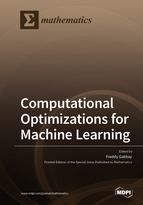Computational Optimizations for Machine Learning
A special issue of Mathematics (ISSN 2227-7390). This special issue belongs to the section "Mathematics and Computer Science".
Deadline for manuscript submissions: closed (30 November 2021) | Viewed by 30416
Special Issue Editor
Interests: artificial intelligence; machine learning and deep neural network algorithms; deep compression of machine learning; explainable AI (XAI); high performance computing algorithms and acceleration; computation systems and algorithm modeling and simulations
Special Issues, Collections and Topics in MDPI journals
Special Issue Information
Dear Colleagues,
In the recent decade, machine learning has emerged as an indispensable tool for incredible number of applications such as computer vision, medicine, fintech, autonomous systems, speech recognition, traffic management, social media, and many others. Machine learning models provide state-of-the-art and robust accuracy in various applications. The increasing deployment of machine learning algorithms introduces major computational challenges due to the explosive growth in model size and complexity. These challenges have been further emphasized due to the diverse hosting platforms from edge devices and cloud systems to high-performance computing. Given that each platform introduces different computational and cost constraints, the need for computational optimizations that are fine-tuned to the application and platform is crucial. This Special Issue looks for novel developments of computational optimizations for algorithms in the domain of machine learning algorithms such as:
- Supervised, unsupervised, reinforcement, and hybrid machine learning classes.
- Various types of machine learning algorithms: deep neural networks, convolutional neural networks, GANs, decision trees, linear regression, SVM, K-means clustering, Q-learning, temporal difference, deep adversarial networks, etc.
- Application-specific machine learning models.
- Machine learning optimization methods such as pruning, deep compression, and others.
Prof. Dr. Freddy Gabbay
Guest Editor
Manuscript Submission Information
Manuscripts should be submitted online at www.mdpi.com by registering and logging in to this website. Once you are registered, click here to go to the submission form. Manuscripts can be submitted until the deadline. All submissions that pass pre-check are peer-reviewed. Accepted papers will be published continuously in the journal (as soon as accepted) and will be listed together on the special issue website. Research articles, review articles as well as short communications are invited. For planned papers, a title and short abstract (about 100 words) can be sent to the Editorial Office for announcement on this website.
Submitted manuscripts should not have been published previously, nor be under consideration for publication elsewhere (except conference proceedings papers). All manuscripts are thoroughly refereed through a single-blind peer-review process. A guide for authors and other relevant information for submission of manuscripts is available on the Instructions for Authors page. Mathematics is an international peer-reviewed open access semimonthly journal published by MDPI.
Please visit the Instructions for Authors page before submitting a manuscript. The Article Processing Charge (APC) for publication in this open access journal is 2600 CHF (Swiss Francs). Submitted papers should be well formatted and use good English. Authors may use MDPI's English editing service prior to publication or during author revisions.
Keywords
- machine learning
- deep neural network
- deep compression
- machine learning optimizations
- machine learning under constrained resources






